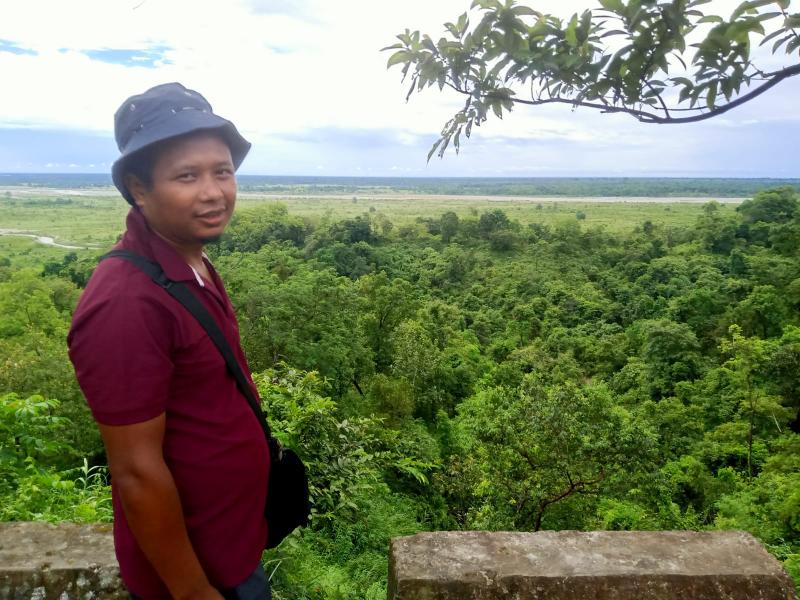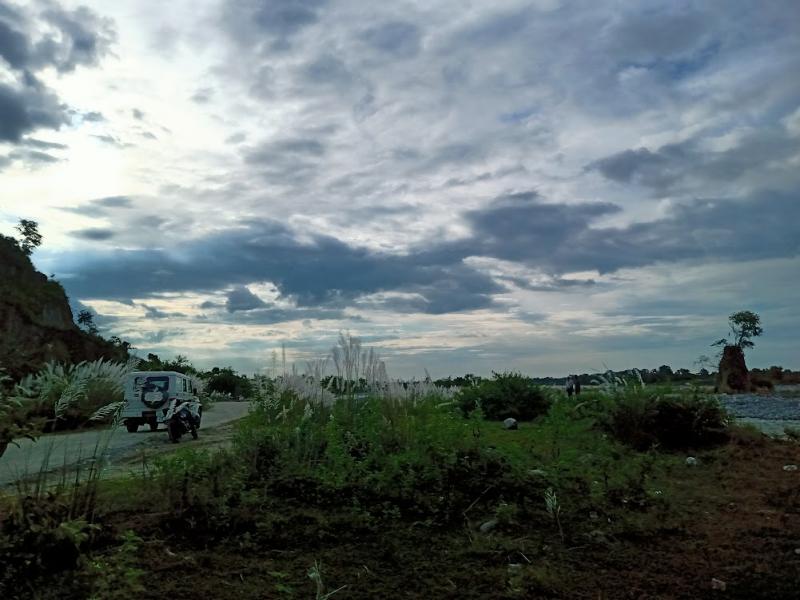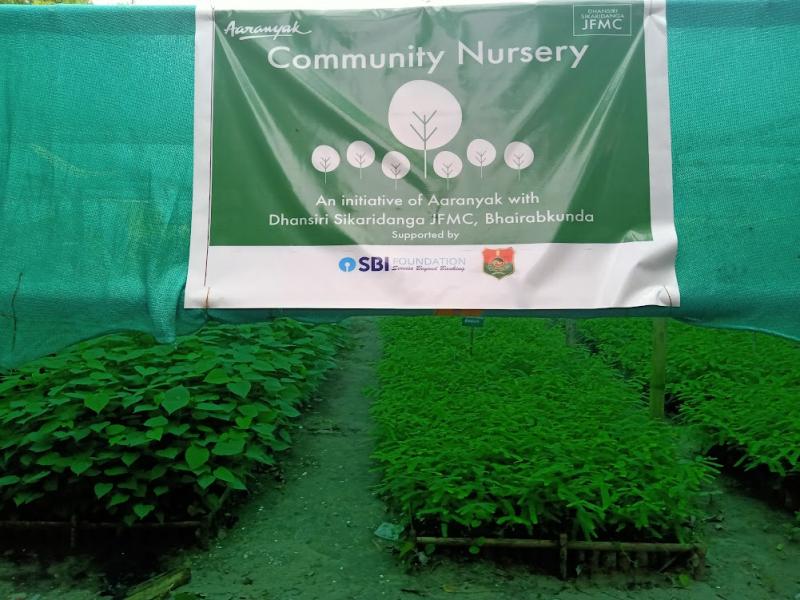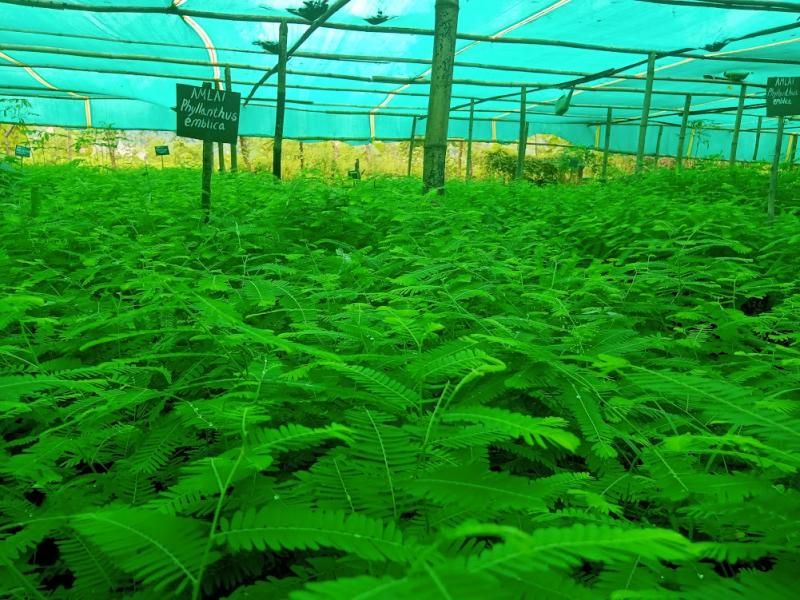Ten years back, standing on the vast patch of barren land along the river Dhansiri in Bhairabkunda area, Didom Daimary, Praloy Daimary, Bineswar Daimary and other members of Joint Forest Management Committees (JFMC) were clueless as to where to make a start. These youths dreamt of turning the entire stretch of 600 (over 4,500 bigha) hectares of barren land along the riverbank green again by regenerating the forest that was lost.
The area is a part of Rowta Reserve Forest under Dhansiri Forest Division in Udalguri district of Bodoland Territorial Council(BTC). The plot suddenly became barren and wore a desert look when a hill came crashing down due to a catastrophic flood, subsequent landslide and erosion. The catastrophe occurred way back in 1987.
Photo- Didom Daimary
These youths could, however, hardly imagine that within just ten years, the barren patches would become an ecologically rich forest to provide safe home to unique faunal resources, including some of the critically endangered ones. Their dream was more powerful than the challenge. As trees planted by them are growing tall and large, images of the barren patches are getting erased.
Dhansiri Sikaridanga Joint Forest Management Committee (JFMC)’s manmade forest now shelters unique Bengal florican listed as ‘critically endangered’ species by IUCN Red list, capped langur, slow loris, black bear, monitor lizard, a number of snake species including rock python, black francolin, rhesus macaque, gecko, leopard, black drongo, barking deer, serow(wild goat), wild boar, civent cat and hornbill among others. A herd of elephants, regular visitor, feasting inside the regenerated forest has become a regular sight from viewpoints of adjacent hills is an added attraction for nature lovers and other tourists.

Photo- Sushanta Talukdar
The youths belonging to Bodos, an indigenous community and the single largest plains tribe of Assam, who prefers to live in close relationship with nature were determined regenerate the forest. However, during the process they have realised it was not only a mere story of determination but also of endless efforts, meticulous planning, and research-work to grow a forest that provide a safe space to wide-ranging animal species.
“Presence of enormous faunal and avian resources in such a small area demonstrates the health of the eco-system that supports shelter, safe passage and food for animals and birds” says Didom Daimary, a member of the JFMC. Didom says they have also spotted presence of a tiny black monkey, who is solitaire and loves to live on the trees. The particular mammal is, however, yet to be identified by them.
Photo- Tonoy Protim Neog
Didom, a birder from childhood, has developed special interest in birdwatching after receiving initial training from Aaranyak, a non-governmental organisation engaged in research-based conservation of biodiversity in India’s northeast region. He has photo-documented 52 bird-species so far inside the regenerated Sikaridanga forest and says there are more to be documented.
Revealing the story of how a reserve forest became barren land, Didom narrates, “Once there used to be a hill on the bank of the river Dhansiri in Bhairabkunda called Maibra. The hill, with thick vegetation was a part of Dhansiri Reserve forest. It was during 1987 that a catastrophic flood caused the river Dhansiri, subsequent landslide almost the entire Maibra hill was eroded away.”

Photo: Sushanta Talukdar
He says the entire hill crashed leaving only a small portion. The tiny portion still stands like an island in the middle of Dhansiri river at Bhairabkunda point. The sand, dust and rocks of the hill made the entire area look like a desert. The entire stretch was covered only with dust and rocks until they decided to regrow the lost forest.
On the foothills of Himalayan Mountain range, Bhairabkunda is a tri-juncture of Assam-Arunachal Pradesh boundary and India-Bhutan border. It is the confluence of river Jampani flowing from Bhutan and Bhairavi flowing from Arunachal Pradesh. Here the river receives the name Dhansiri.
Photo- Didim Daimari
The catastrophic event was followed by illegal activities like encroachment and rampant felling of trees. During 2013, over 600 families who came from different pockets of Kokrajhar, Baksa, Dhekiajuli, Goalpara, Sonitpur and from nearby areas and settled there. These families belonged to Bodo, Santhal, Adivasi and Rabha communities. They were requested by JFMC members to vacate the land so that they can regrow the lost forest.
“However, three families refused to return. Then, on one night these families were attacked by a herd of elephants killing a woman in 2016. Since then, there has been no human settlement inside the forest’, Didom adds.
Photo : Didom Daimari
Didom belongs to one of the 115 families, united under 11 village-level JFMC groups to form ‘Dhansiri Sikardanga Joint Forest Management Committee. Certain areas were demarcated for each group for planting of saplings and nurturing the forest. Each of the village level committees have three women members. The members meet every after three months to discuss various matters.
The name of the forest is derived from Sikaridanga village. Way back, hunting was main occupation of the villagers. Memories that today’s generation have inherited from elders suggest that once the areas was covered with thick vegetation and there were abundant wild animals. Herds of deer were frequent visitors. The villagers used to hunt deer, an easily available prey, for human consumption. ‘Sikaridanga’ literally means ‘the person who lift the animal that was hunted.’
“To translate our dream into reality was indeed a herculean task. The department of Forest and Environment, BTR initially provided us some saplings of plants. During initial phase, we planted tree saplings of all the kinds that we could collect. In addition to the trees, some portions of grassland have grown naturally in the vicinity. Adding to richness of tree varieties, the JFMC members have also planted Alpine grass, which is a delicacy for elephants ”, says Proloy Daimary a JFMC member.

Photo : Sushanta Talukdar
Their dream took a new direction with the guidance of Aaranyak, which guided them to plant saplings of locally available tree species instead of planting saplings haphazardly. Aaranyak guided them to collect seeds and saplings of trees from the forest areas of the area to restore the original eco-system.
The forest is co-managed by Department of Forest and Environment (BTC) and JFMC. Seventy percent ownership of the forest is with the JFMC and rest 30 per cent with the department. Initial investment was managed with personal contribution from the group members. For vigilance, each group offer rotational duty.
“It took us some years to understand what type of trees would survive on the area and what kind of saplings should we plant. With guidance of Aaranyak we have been collecting seeds of various locally grown trees, try to grow saplings in a nursery and plant them with proper planning. Growing a forest maintaining the original eco-system is a different approach from mere plantation drive. Since 2019 we have started a community nursery for the purpose.” Didom, who is also a field coordinator, Aaranyak says.

Photo: Sushanta Talukdar
He says that JFMC members drew inspiration from success story of Getshemane manmade forest in Bhairabnkunda hand-raised by 35 Bodo youth through planning of 14 lakh saplings on over a period of five years from 2007 and 2012. The original forest was lost in devastating flood caused by the river Dhansiri.
Aarnyak has installed solar-powered fence to protect the community nursery from elephants.
“The objectives of Community nursery are to developing native planting material, along with generating stock of wild species through collection of seeds and seedling for regeneration. Again, the growing saplings are planted in degraded land and forest as a part of restoration initiative” says Jayanta Kumar Sarma, Senior Programme Associate of Natural Resource Management Programme.
The nursery has now saplings of aamla (Phyllanthus emblica), silikha(Black myrobalan), khoyer (Senegalia catechu), arjun (Terminalia arjuna), ejar (Lagerstroemia speciosa), gamari (Gmelina arborea), simlu (Bombax ceiba), sishu ( Dalbergia sissoo ), bhelkor among others. Khoyer is a favourite food plant of elephants.
This year 25,000 plants of 34 food species have been planted so far. About 100 hectares of the forest is yet to be planted.
Photo-Didom Daimari
“Dhansiri-Sikaridanga JFMC under Rowta RF is now a home to a number of wildlife species of which some important species includes the Asian elephants, Bengal florican, slow loris and many other. So to keep the ecosystem intact and replenish the habitat, we took a 3 year habitat restoration plan supported by SBIF which is ongoing. The restoration project is also a long term plan to improve the habitat connectivity of Asian elephants. We took a survey to study the native forest cover adjacent to the JFMC site which is also a part of Rowta RF and listed out the species that would be suitable for plantation and serve as fodder and food to birds and animals. In addition we have also created a nursery of the listed plants and the saplings will be planted in the site” says Rabiya Daimary Project Officer Aarnyak.
For sustenance the group members have designed a series of income generating activities like eco-tourism camp and trekking. A natural salt lick in Jelkhana Pahar, is an added attraction, where various wild animals come to lick salt from the ground.
“Tourists have shown keen interest to visit the forest. However, construction of toilet and drinking water is still a challenging issue”, says Bineshwar Daimary, a member.
Photo: Tonoy Protim Neog
The village level groups have also developed various income generating activities. Some of these villages have potentially for fisheries while others for dairy-farming and others. There is a sources of Bhumuk (spring water) near Kukur Bhukiya village JFMC, which is ideal for fisheries. This village also have potentiality for dairy-farming. All the villages have the capability of livestock as livelihood opportunities. The Angrajuli village, which is located in tri-juncture of Assam-Arunachal Pradesh and Bhutan, has already come up with home-stay facilities.
“After spending nearly 10 years- the most productive period of our life in growing a forest, it is high time that we upgrade our life with meaningful livelihood activities. We are very positive about the forest. However, to sustain the forest and its ecology, we must have to improve our individual life too ” says Didom.